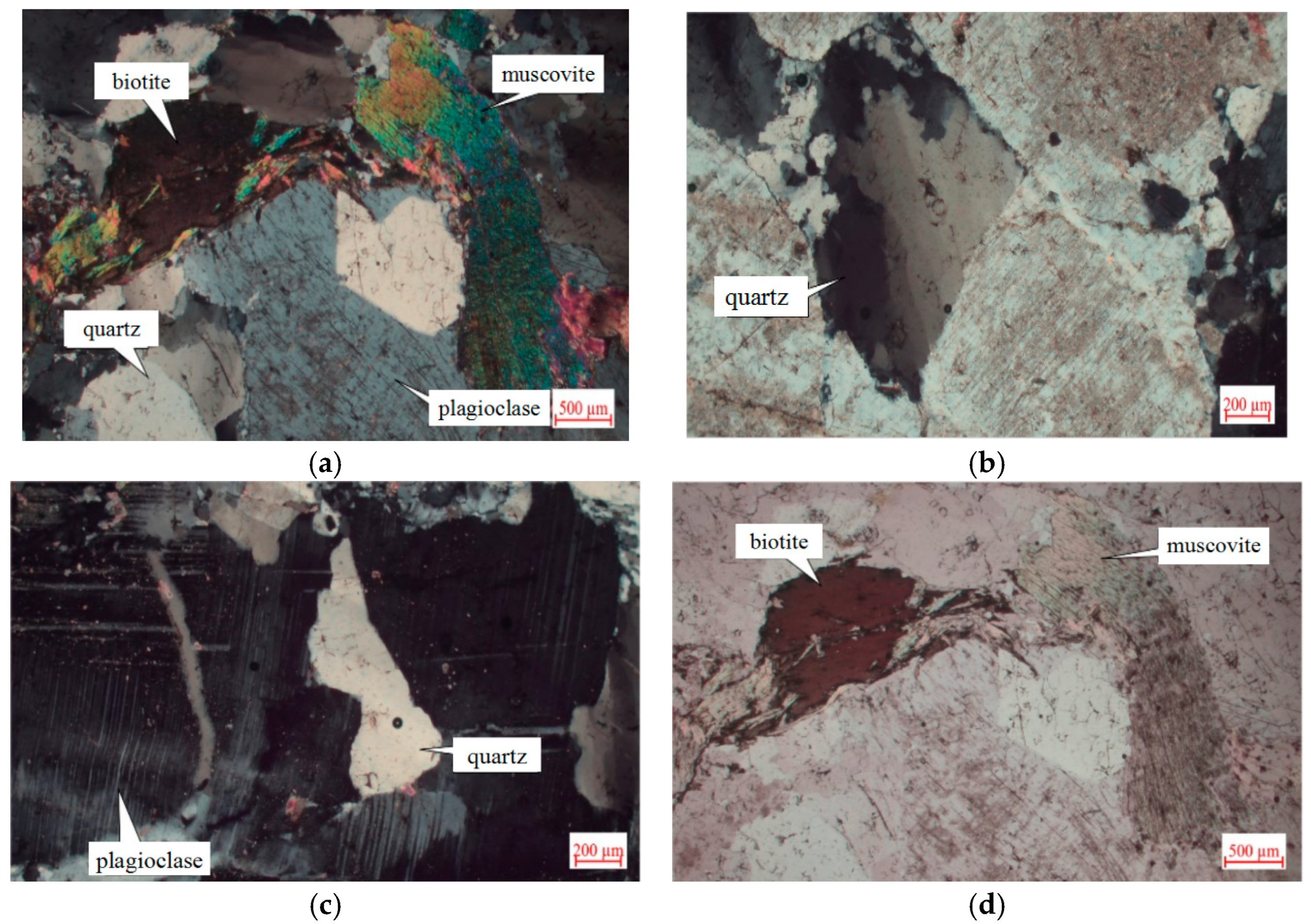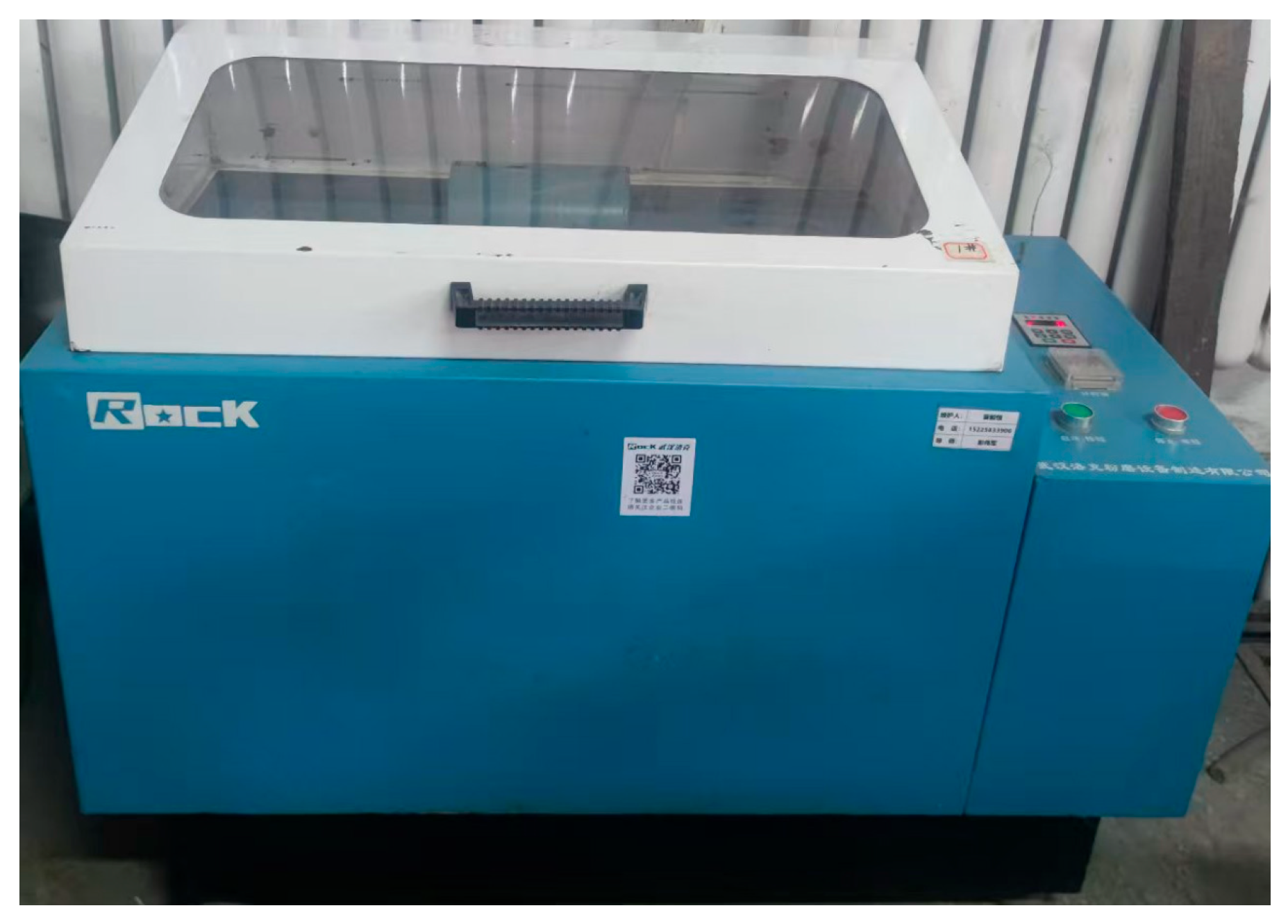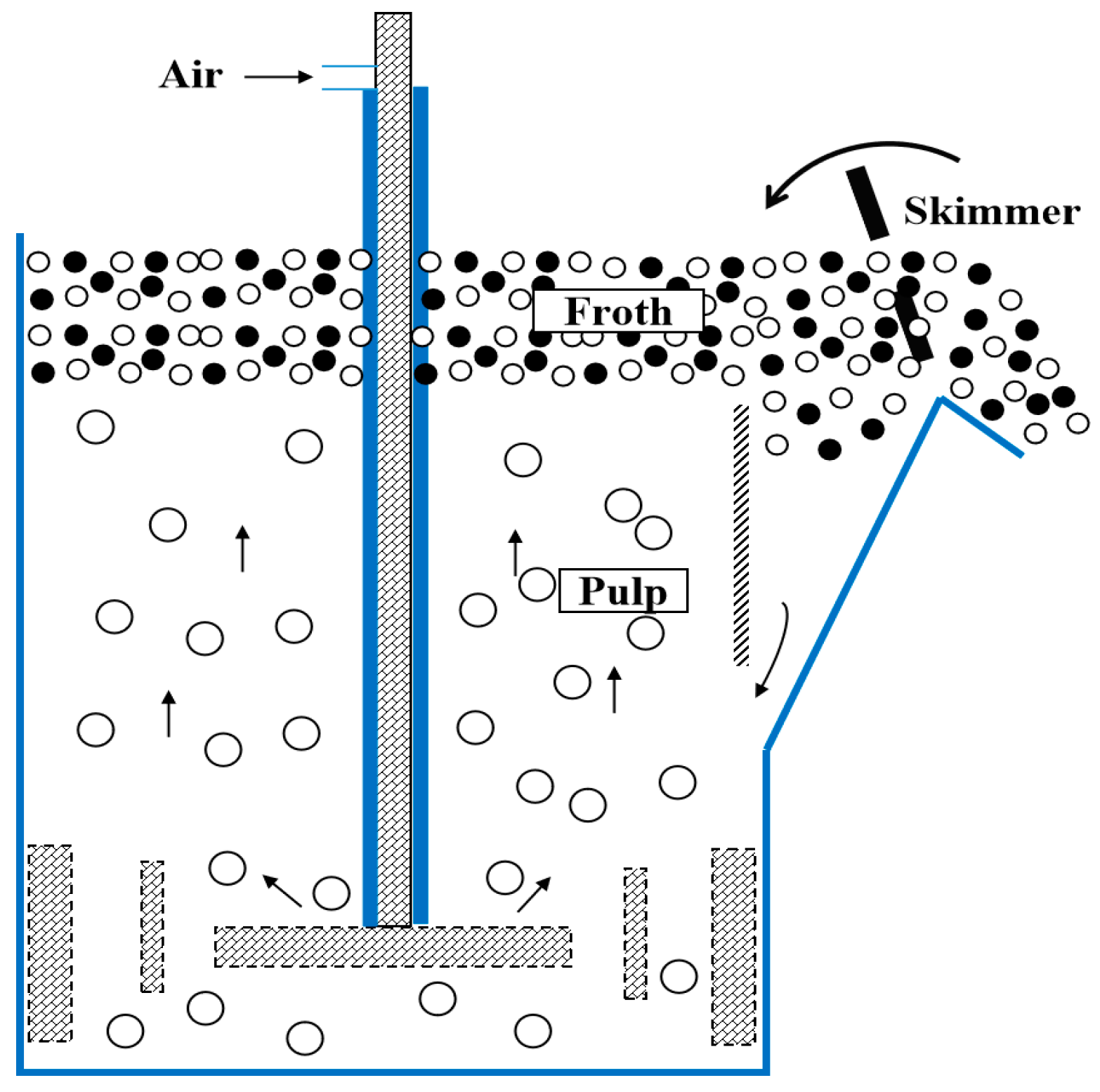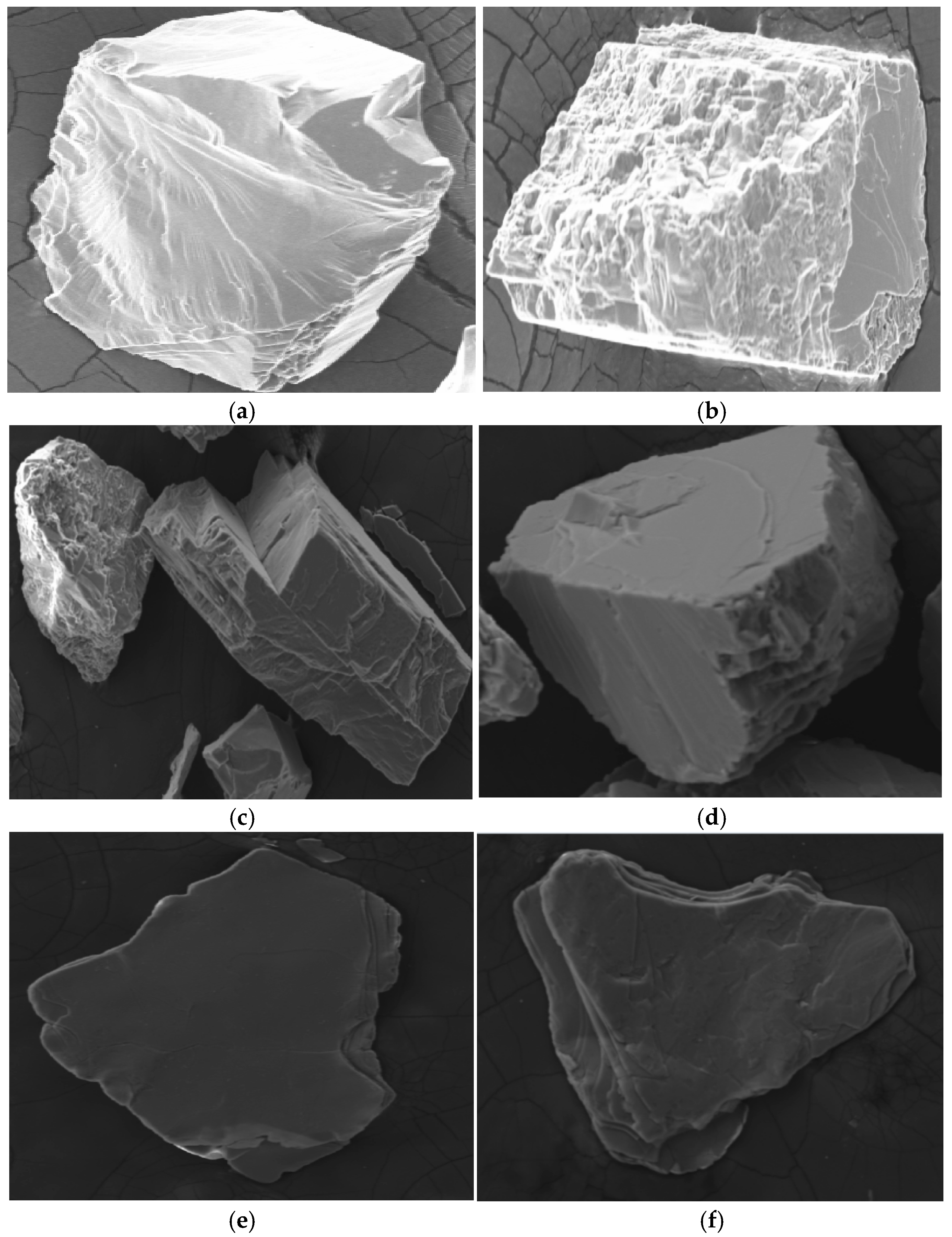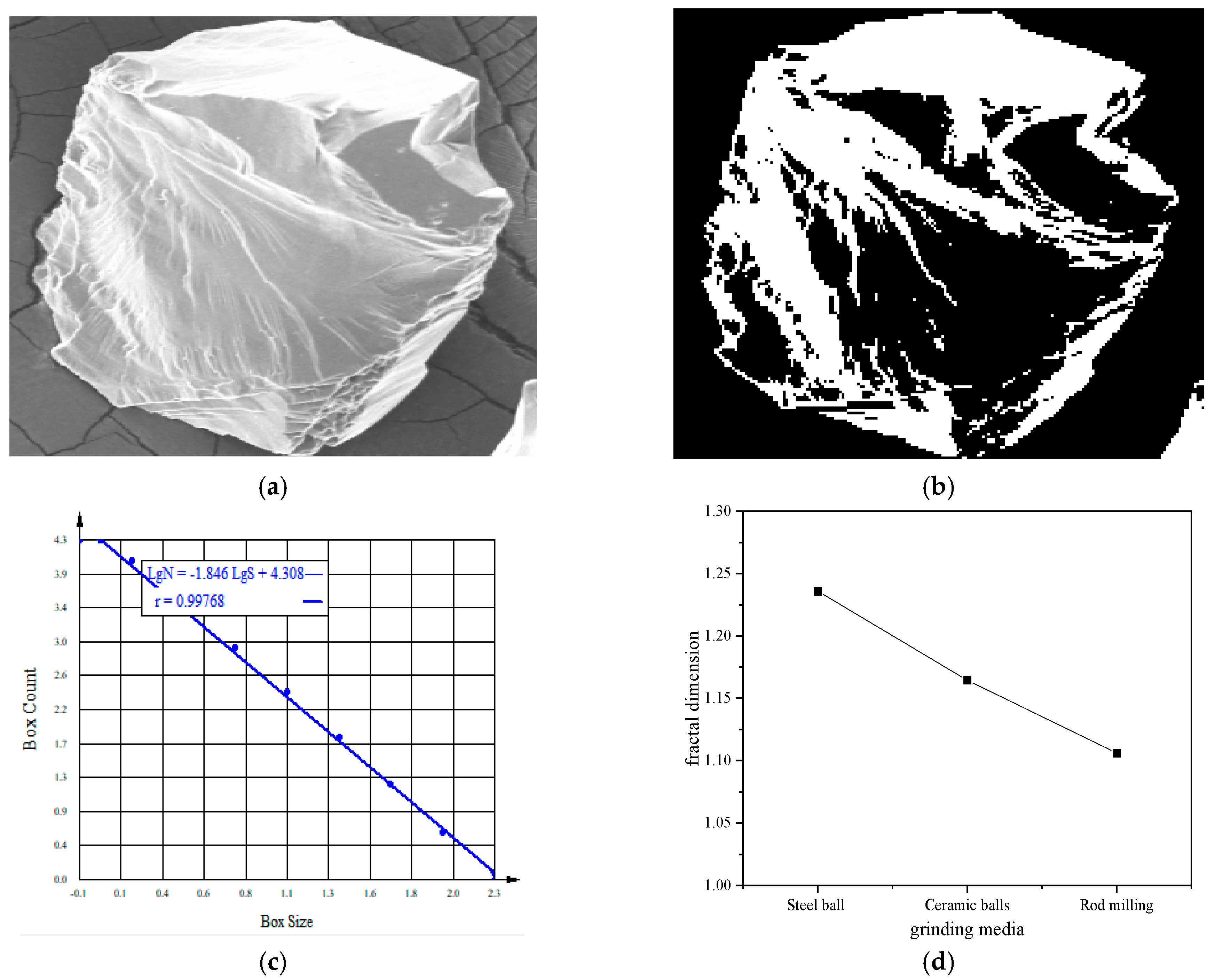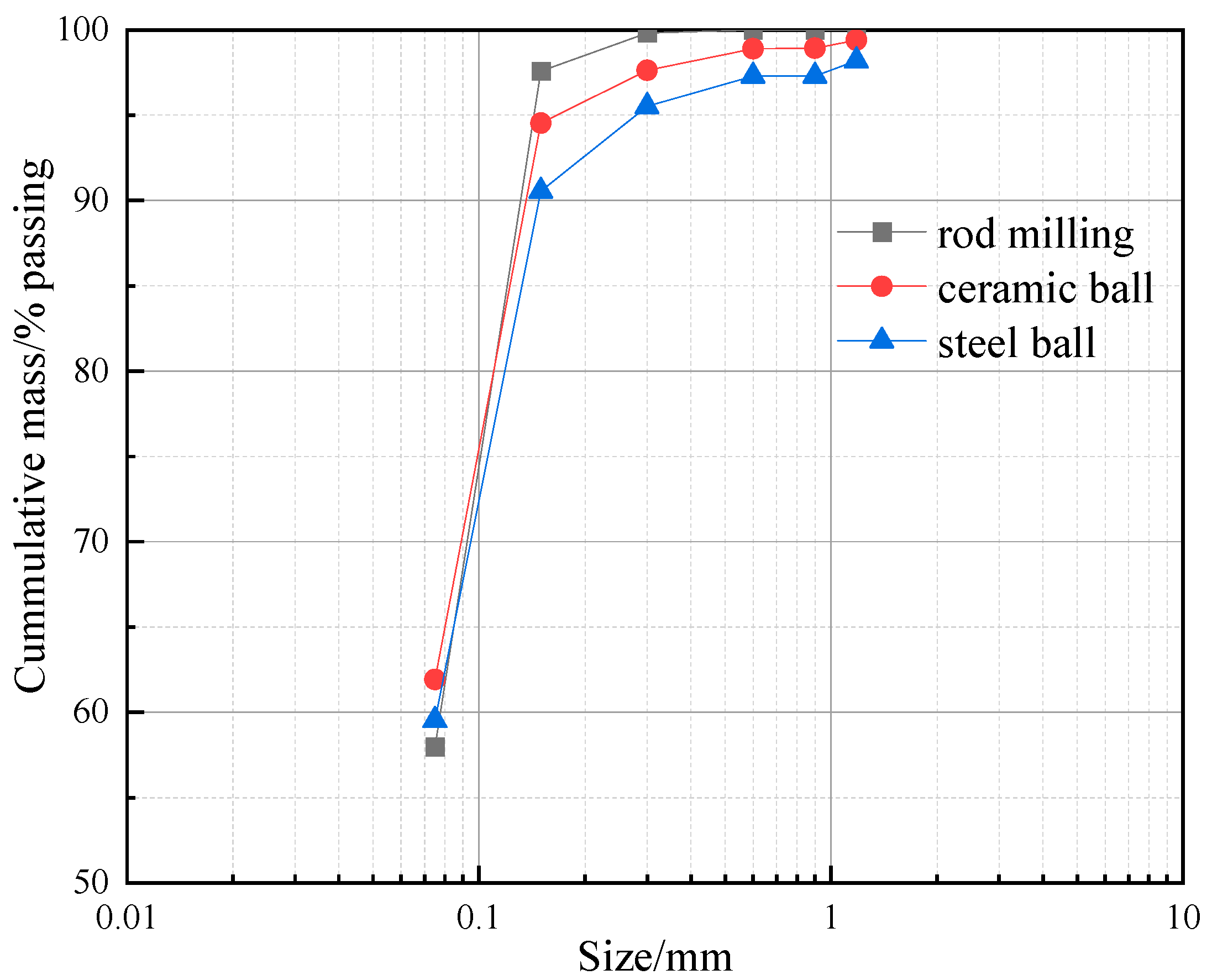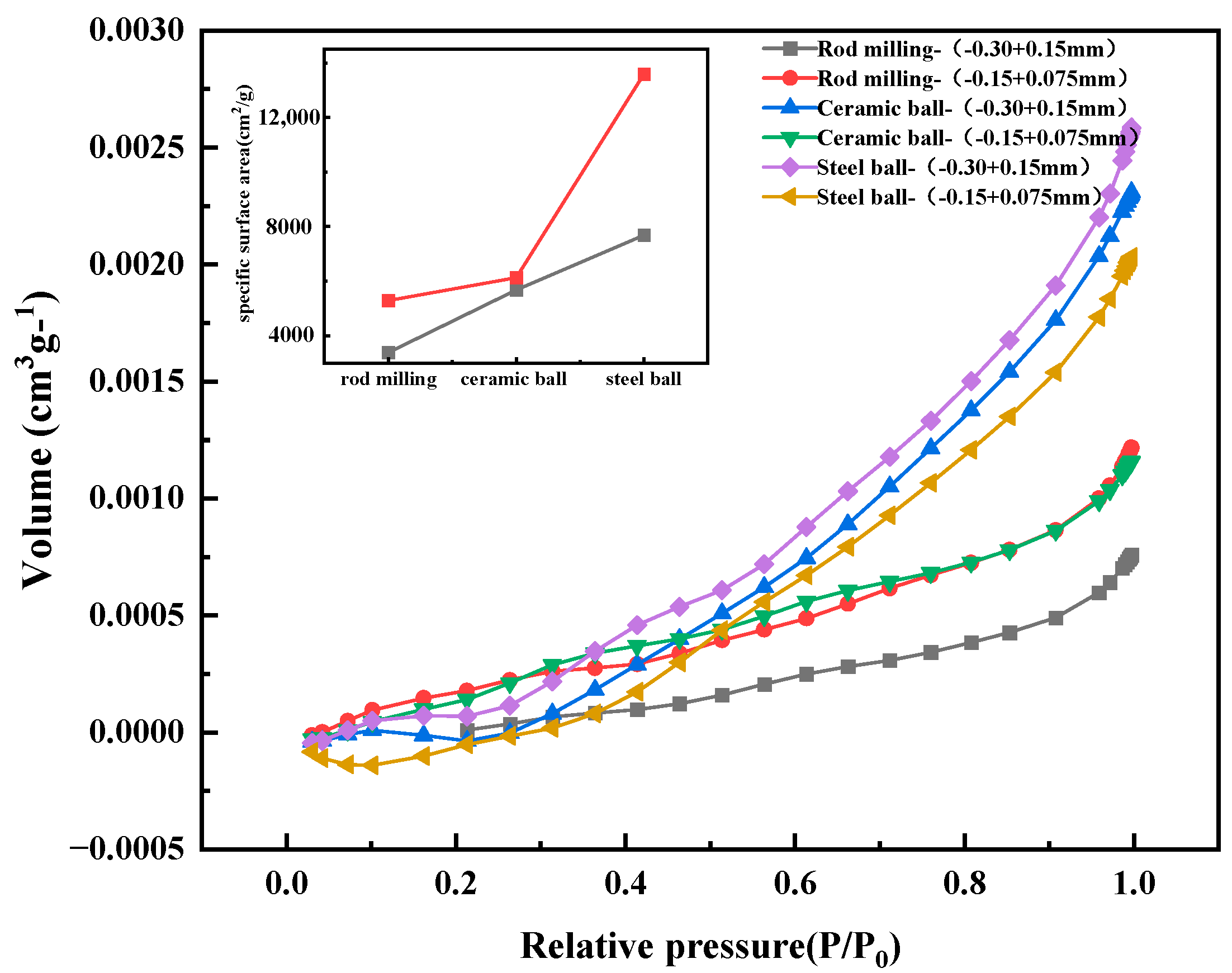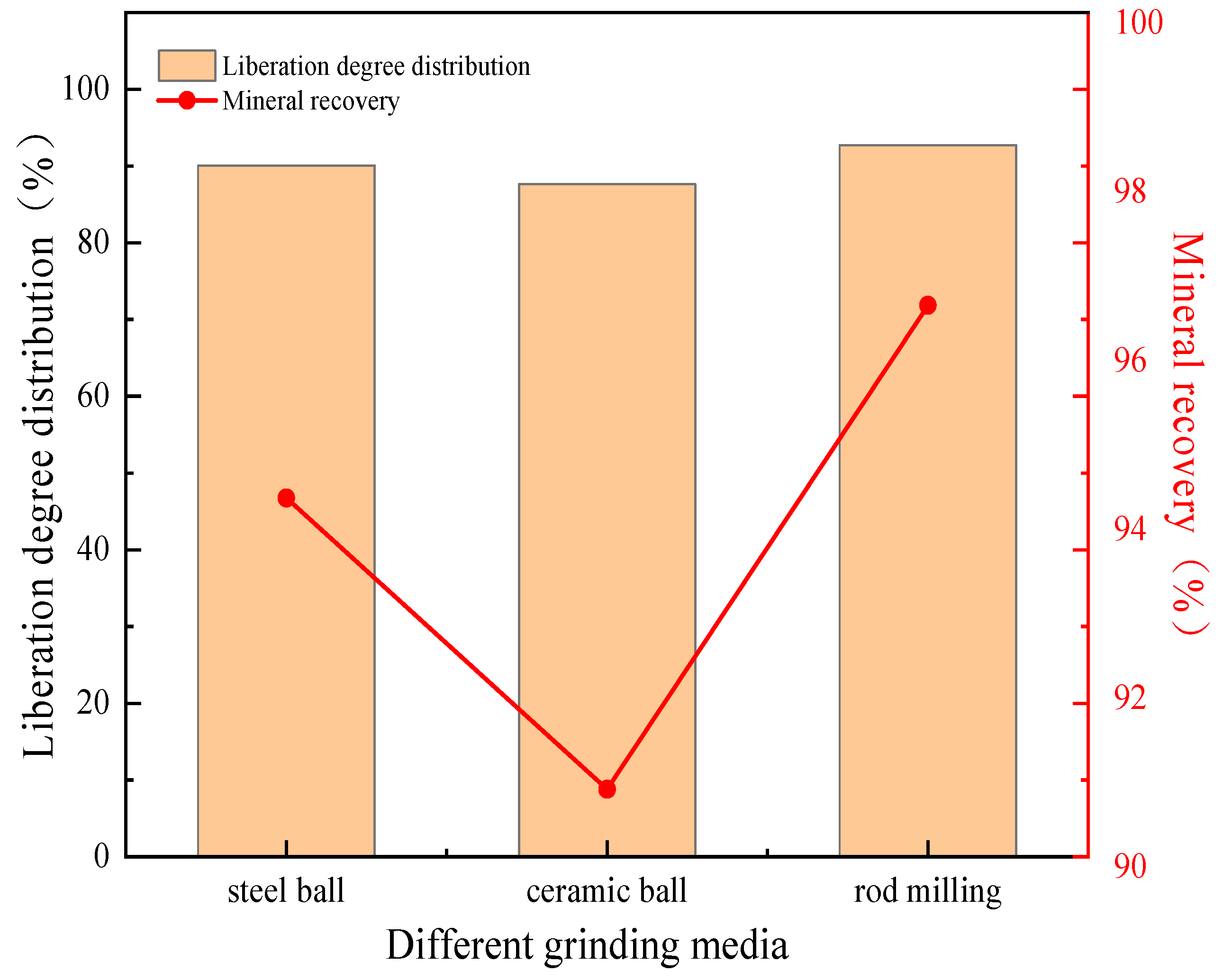1. Introduction
High-purity quartz refers to quartz that contains more than 99.9% SiO
2 after purification and an impurity content that meets industry standards [
1]. Due to its excellent performance, high-purity quartz is widely used in photovoltaics and semiconductors and is an emerging strategic non-metallic mineral resource. Research shows pegmatitic quartz deposits have become targets for high-purity quartz resources due to their large scale, low impurity, stable quality, and low fluid inclusion content [
2]. High-quality quartz raw materials of 4N8 grade and above have currently only been found in the muscovite granite pegmatite resources of the Spruce Pine area in North Carolina in the United States. In China, granite pegmatite deposits are mainly distributed in the Henan and Xinjiang regions [
3]. From quartz ore to quartz sand, the process primarily involves crushing and grinding. The primary focus of ore grinding is to liberate minerals and decrease their particle size, which requires a substantial amount of energy [
4]. A large fraction of total energy consumption is attributed to ore grinding operations, accounting for approximately 40%–50% of the overall energy utilized and equating to roughly 2% of the country’s gross electricity generation [
5]. In contrast, the portion of energy effectively utilized in this procedure is small, ranging from about 3%–8% of the initial energy input [
6]. Among them, the grinding medium directly affects the ore crushing mode and energy consumption distribution; therefore, understanding the characteristics of ore breakage is crucial for optimizing ore grinding and minimizing energy consumption.
In the grinding process, the ore particles are broken or comminuted by the impact, extrusion, shear, and other forces generated by the grinding medium (such as steel balls and steel rods). Various studies have investigated the fragmentation behaviors of particles [
7]. Breakage within a group setting becomes intricate due to the exchange of energy among the particles. Moreover, the grinding medium is the most important factor affecting mill energy consumption, steel consumption, and particle size characteristics of grinding products. Grinding efficiency is affected by the shape, size, ratio, material, movement form, and spatial arrangement of the medium in the mill [
8,
9].
At present, domestic and foreign scholars have developed many shapes of grinding media, such as short cylindrical, conical, truncated conical, elliptical, and other irregular media, among which the medium is widely used. In the grinding process, the action mode of the medium in the grinding section and the mineral particles is both point and line contact, which can effectively avoid overgrinding and has high grinding efficiency. It has been successfully applied in the fine grinding operation of metal ores and other fine grinding operations, effectively improving the utilization rate of resources. According to Gao et al. [
10], the action of grinding media with different shapes results in different degrees of crystal plane exposure after mineral cracking. The rod mill promotes fluorite and scheelite to produce more crystal-exposed surfaces, and the ball mill grinding effect is poor [
11]. Nyoni et al. [
12] used four common grinding media to carry out grinding tests to study the effect of grinding products on the flotation effect under different media. The results showed that the grinding products had a better flotation effect under the action of Mild steel rods.
Exploring the correlation between energy and mineral liberation should aid in developing a model for particle breakage. Nevertheless, the complexity of mineral liberation has hindered the establishment of a clear connection between energy input and mineral liberation. Garcia et al. developed a system to measure the area of mineral interfaces using X-CT reconstruction images, which enabled the computation of the ratio of areas occupied by various mineral interfaces, both before and after particle breakage [
13]. This revealed valuable insights into changes in interfacial properties; it was observed that minerals primarily undergo intergranular fracture at low energy levels, promoting their liberation. Fu et al. studied the characteristics of coal breakage through an impact test system; their analysis of mineral liberation revealed that within a specific energy range, the fracture of interfaces among various minerals would contribute to increased liberation [
14]. Mariano et al. performed breakage tests on pyrites and copper sulfides at varying energy levels using the JKRBT (Julius Kruttschnitt Rotary Breakage Tester), leading to the conclusion that the distribution of mineral liberation remained relatively unaffected by the applied energy [
15]. Si et al. used eight different ball diameters in grinding processes, revealing that the enhanced breakage energy resulting from larger ball diameters could impede the liberation of minerals [
16,
17]. A grinding medium can change the breakage mode of ore, and the optimization of a grinding medium can improve mineral liberation in the grinding product while also preventing excessive grinding.
Steel balls, ceramic balls, and other spherical grinding media involve point contact. Compared to steel rods and other rod-shaped media in the grinding process, they have a stronger impact and a stronger grinding effect. However, steel rods and other rod-shaped grinding media, because of their contact with the mineral in the grinding process, have line contact, so their grinding product size is more uniform. Therefore, steel rods are suitable for grinding brittle minerals with small hardness, and their grinding efficiency is relatively low. In the case of the same size of the ball, the ball material also has a great impact on the grinding. Steel balls are suitable for grinding hard ores, and their wear resistance is good, which can prolong the service life. Ceramic balls, as a new type of grinding media, have the characteristics of high wear resistance, high toughness against grinding, and strong surface grinding force. Compared with steel balls, ceramic balls are more effective in the light grinding of crushed materials and can reduce the overgrinding phenomenon of ores. However, ceramic balls have a lower density, and a higher filling rate may be required to achieve the same grinding effect as steel balls.
Therefore, in order to obtain an efficient grinding method for preparing high-purity quartz, adjusting the ore grinding method is crucial for improving the mineral liberation degree. With this background in mind, we use different grinding media to conduct grinding experiments on muscovite granite pegmatite, exploring the influence of the grinding methods on product particle size distribution, mineral liberation degree, and breakage mode. This study provides theoretical support and empirical data for applications involving the grinding and disintegration of quartz and feldspar.
3. Results and Discussion
3.1. Particle Morphological Properties
Fractography is a science that studies the morphological characteristics of fractures, such as type, mode, path, processes, and properties [
19]. Due to the heterogeneity of rocks, that is, the diversity of mineral particles and the anisotropy of mechanical properties of mineral crystals, there are complex impacts on mechanical mechanisms. In this experiment, the micro-fracturing mechanism of muscovite granite pegmatite was analyzed through SEM images of the fractures of muscovite granite pegmatite-type quartz under different force application methods. Accordingly, the product particles under different grinding methods were graded, and the surfaces of the particles were cleaned by an ultrasonic method after the particles were divided. The samples were sprayed with gold, and the images were then analyzed by scanning electron microscopy.
The morphological characteristics of quartz ore subjected to different grinding methods are shown in
Figure 4. Since quartz has no cleavage, high strength, and high hardness, and the content of quartz in granite is large, the crystal cluster during crystallization is relatively large. The brittle fracture morphology of quartz minerals is mainly an irregular intergranular failure, which will produce some shell-like, step-shaped, and river-like fractures, among other shapes. The morphological characteristics show that the rock is affected by heterogeneity and lattice defects when brittle fracture failure occurs under tensile stress. It can be seen from
Figure 4a,b that under the action of a ceramic medium, the fracture morphology of quartz is dominated by river patterns. When cleavage cracks are generated and expand in a certain grain or propagate from one grain to adjacent grains, they will be disconnected on different crystal surfaces to form cleavage cracks. Steps will be formed at the intersection of these cleavage cracks, and the dissociation steps show a river-like morphology in the SEM images. It is clear from
Figure 4c,d that under the action of steel ball medium, the fracture morphology of quartz is mainly step-like. Because there are different cleavage planes or joint planes inside the ore, under the impact of the steel ball medium, the crack propagates along these cleavage planes or joint planes, and a step-like fracture is formed at the intersection. From
Figure 4e,f, one can see that under the action of the rod grinding medium, quartz slips and breaks along the dissociation plane or crystal plane, and a large number of shear bands and flat surface patterns appear in the microscopic fracture morphology. The above analysis shows that the quartz fracture morphology produced by different grinding media varies significantly. For the same ball diameter, the grinding energy produced by steel balls is larger than that produced by ceramic balls during the throwing process, and the stress wave propagation rate in the ore is higher. The force application method of the rod mill is mainly extrusion grinding, and the stress wave propagation in the ore is lower. Therefore, the main reason for the difference in quartz fracture morphology is the difference in the propagation rate of the stress wave generated in quartz during the force application.
3.2. Fractal Characteristics of Fracture Surface Roughness
The fracture of ore is affected by many factors in the process of grinding, and the fracture surface is often very irregular and rough. The fracture surface morphology reflects the mechanical properties of the ore and the fracture mechanism of the grinding process. Quantitative analysis of fracture surface roughness can provide information that cannot be obtained by macroscopic fracture mechanics analysis methods. The conventional fracture surface morphology is usually qualitatively divided into brittleness, toughness, a mixed form, etc. Such a classification method makes it difficult to combine the microscopic mechanism of fracture with the macroscopic mechanical parameters.
The fractal dimension regression line of the quartz fracture is obtained using the Fractal Dimension software 1.0 (Xuzhou, China) [
20], and the linear fitting degree reaches 0.997, as seen in
Figure 5a–c. This indicates that this fractal method is reasonable for the quantitative detection of fracture roughness. From
Figure 5d, the fractal dimension of quartz mineral fractures is directly correlated with the characteristics of the grinding medium. The fractal dimension of the fracture morphology under the action of the steel ball medium is larger, and the fractal dimension of the mineral under the action of the rod grinding medium is lower. Relevant studies have shown that the fractal dimension of the fracture morphology of a rock increases with the increase in grinding energy and that the two have a linear relationship. Moreover, under the same grinding conditions, the grinding energy of the steel ball medium applied to the quartz mineral is large, and the grinding energy generated by the rod grinding medium is low. The larger the diameter of the steel ball, the greater the impact energy generated by the steel ball thrown down during the grinding process, the greater the crack propagation rate generated by the ore during the crushing process, and the greater the roughness of the fracture morphology. The fracture mode of the mineral is mainly transgranular fracture, and the fractal dimension of the fracture morphology is also larger. Therefore, the fractal dimension as a quantitative index describes the roughness. This index can reflect the fracture mode and fracture mechanism of quartz minerals under different grinding media.
3.3. Particle Size Distribution and Liberation Properties
The purpose of grinding is to separate the useful components in minerals into single-component particles so that the required particle size for subsequent mineral processing operations can be reached, enabling effective recovery. The particle size distribution of the ground product has a direct impact on mineral separation, and the quality of the concentrate is largely determined by the quality of the ground product. If the ground product particle size is insufficient, then the target mineral will be difficult to effectively recover, no matter which beneficiation method is used. The ground product is over-crushed; it will worsen product indicators, increase the number of flotation reagents, cause the reagents to lose selectivity in the flotation stage, hinder flotation processes, and make flotation processes difficult to control. When minerals are ground effectively to the required particle size for flotation, the yield of qualified particles in the product and the efficiency of the grinding system will both be higher.
Impact energy is an important factor affecting the crack growth rate. Under the impact load, as the impact energy increases, the stress generated inside the material increases, which accelerates the crack propagation, and the crack propagation rate usually increases. The crack propagation rate not only affects the failure rate of the material but is also closely related to the fracture mode. When the crack propagation rate is faster, the material is more prone to volume fracture because the crack will quickly pass through multiple grains of the material. When the crack propagation rate is slow, the material is more likely to undergo surface fracture because the crack may be affected by surface defects or stress concentration during the propagation process. The magnitude of the impact energy also affects the fracture mode of the material. At higher impact energy, the material is more prone to volume fracture because the crack has enough energy to penetrate the interior of the material. At lower impact energy, the material is more likely to undergo surface fracture because the crack may be limited by the surface factors of the material during the propagation process.
Different crushing methods affect the particle size distribution of the product through the form of force (extrusion, impact, grinding), energy utilization rate, and selective crushing of ore, so that the particle size of the crushed product is significantly different. The comminution of ore in a rod mill is primarily accomplished through impact and extrusion. During the grinding process, the grinding rods exhibit a superior crushing effect on coarse-grained ores. Fine-grained materials can pass through the inter-rod gaps, which effectively prevents the over-comminution of fine-grained mineral materials. Consequently, the rod mill possesses the characteristic of selective grinding, resulting in a more uniform particle size distribution of the ground products. The ball mill mainly relies on the impact force generated by the steel ball being thrown from a high place to break the ore. In contrast, the impact force generated by the ceramic ball is relatively small compared to the steel ball, so the generated grinding force is smaller. The particle size distribution of ore products under different grinding media is shown in
Figure 6. There are obvious differences in the particle size distribution of grinding products under different grinding media. An analysis of the particle size distribution ratio between rod and ball milling products shows that, compared with ball milling, the particle size distribution of the products after rod milling is more detailed, while the particle size of the grinding products of ceramic balls is coarser than that of steel balls. The main reason for this is that the grinding energy generated by ceramic balls is smaller than that of steel balls (for the same ball diameter). The degree of breakage is primarily influenced by inherent microcracks and other imperfections within magnetite ores. Based on the theory of particle breakage proposed by Martins et al. [
21], particles within the −2.00 mm size range primarily undergo volumetric and crack fractures.
During mineral sorting, ores undergo breakage and grinding to facilitate mineral liberation, with the pivotal factor being the energy utilized during impact breakage. Consequently, we employed mineral liberation analysis to evaluate the liberation degree of muscovite granite pegmatite being crushed into varying sizes under different energy levels. To guarantee data accuracy, each sample underwent testing on over 30,000 particles.
Figure 7 displays the liberation degree distribution of quartz and feldspar under different grinding media. In the particle size range of −0.30 + 0.15 mm, the liberation degree of quartz under the action of ball, ceramic, and rod milling media is 52.29%, 60.80%, and 66.78%, respectively. In the particle size range of −0.15 + 0.075 mm, the liberation degree of quartz under the action of ball, ceramic, and rod milling media is 77.35%, 67.99%, and 77.41%, respectively. For the particle size range of −200 mesh, the liberation degree of quartz under the action of ball, ceramic, and rod milling media is 90.11%, 87.63%, and 92.70%, respectively. With the increase in grinding fineness, the degree of monomer dissociation increases, indicating that the degree of mineral monomer dissociation and grinding fineness are positively correlated.
In the grinding process, the medium is too large, and when the impact force is too large, there will be no selective liberation through the grinding; at the same time, the excessive impact force also increases the particle size of excessive grinding; when the ball diameter is too large, the number of hits is reduced, and the coarse grain level is also increased. That is to say, when the energy applied in the grinding process is too large, the selective liberation effect is weakened, and the particle size unevenness of the product is aggravated. As a result, the product liberation degree is low and the particle size characteristics are poor. Therefore, when the energy generated by the medium during the grinding process is accurate, the mineral liberation degree of the grinding product will be higher and the particle size over-grinding will be avoided.
These results show that the energy required for coarse-grained grinding is large and that the liberation degree of the grinding product of the ball mill medium is higher. In the intermediate particle size range, the grinding effect of the ball mill and the ceramic medium is similar, while the grinding effect of the rod mill medium is poor. The primary reason for this is that for the intermediate particle size, there is mainly volume grinding and surface grinding involved. The rod mill mainly relies on extrusion particle grinding, and the relative strength of the ball mill is small. Because the mineral liberation degree is poor in the fine particle size range, the particle grinding is mainly surface grinding, and the force is too large to cause breakage along the particle crystal; also, the grinding behavior is non-selective. And because the quartz liberation degree of the fine-grained product of the rod mill is large, we see that the different force application methods lead to large differences in the liberation degree of the grinding product. Given that the primary objective of comminution is to achieve mineral liberation, with optimal particle size being a secondary concern, ensuring a suitable specific energy input is the most important factor for maximizing the liberation degree of the resultant products.
3.4. The Influence of Mineral Liberation Degree on Flotation Recovery Rate
The specific surface area of grinding product particles was measured by an automatic specific surface area analyzer (Belsorp MAX II, Osaka, Japan), and the effect of the grinding medium on the specific surface area of mineral particles was investigated. These test results are shown in
Figure 6.
It can be seen from
Figure 8 that the specific surface area of the grinding products under three different grinding media varies significantly. In general, the specific surface area of steel ball grinding products is higher than that of the other two media, and the specific surface area of grinding products under rod grinding media is smaller. The larger the specific surface area, the better the adsorption effect on the agent in the subsequent flotation process, and the greater the dosage that is needed.
The effect of mineral liberation degree on the flotation recovery of SiO
2 is shown in
Figure 9. The liberation degree of quartz under the actions of ball, ceramic, and rod milling media is 90.11%, 87.63%, and 92.70%, and the recovery rate of SiO
2 after flotation is 94.25%, 90.8%, and 96.53%, respectively. The fractal dimension is related to the degree of fragmentation and complexity of the mineral particle. As mineral particles are broken into smaller particles, their shapes may become more complex and the fractal dimension usually increases. There is a correlation between the degree of fragmentation and the degree of dissociation of mineral particles. The higher the degree of fragmentation, the larger the contact area between the mineral particles may be, thus favoring the dissociation of minerals. Therefore, the higher the liberation degree of SiO
2 is, the higher the flotation recovery. The degree of mineral liberation directly affects the flotation recovery rate. When the mineral liberation degree is high, intergrowth between useful minerals and gangue minerals is reduced, which is conducive to the collection of useful minerals by flotation reagents; accordingly, the flotation recovery rate is improved. On the contrary, when the liberation degree is low, the useful minerals and gangue minerals are mixed together, which makes separation difficult, resulting in a decrease in flotation recovery.
4. Conclusions
This study presented a grinding experiment conducted on granite pegmatite, focusing on a comparison between steel balls and ceramic rods as grinding media. We investigated how these different media impact the mineral liberation and particle size distribution of the resulting ground products, with the goal of offering insights into optimizing grinding media selection for industrial processes.
Through an analysis of the particle size distribution of the grinding products, it was observed that the grinding particle size under the action of a rod grinding medium was coarser, and the particle size of grinding products under the action of a ball grinding medium was finer, and also prone to overgrinding. The grinding ability of ceramic balls was also weak for fine-grained products. Thus, choosing a suitable grinding medium can optimize the particle size distribution of grinding products.
By using the fractal dimension as a quantitative index, we described how roughness can reflect the development trends of fractures in terms of their modes and mechanisms. The fractal dimension of particle morphology roughness was found to be larger for steel ball-milled products and smaller for rod-milled products.
Through an analysis of the distribution of mineral liberation degree of the grinding products, it was seen that the energy required for a coarse grain grade is larger, the grinding effect of a steel ball medium is generally superior, and the grinding effect of a rod mill is better for fine grain grades. Furthermore, we found that the mineral liberation degree of grinding products, and thus the grinding effect can be improved by optimizing the grinding medium.
The analysis of muscovite granite pegmatite comminution products revealed a trade-off between optimal particle size and mineral liberation degree. A rod mill can improve the dissociation degree of the mineral monomer and the yield of the qualified fraction of quartz minerals through grinding.
Finally, in the same amount of flotation reagents, it was found that the specific surface area of particles was not the main factor affecting mineral flotation and that the degree of mineral liberation had a direct impact on flotation recovery. The mineral liberation degree of rod grinding products was high, the specific surface area was small, and the flotation recovery rate was high. Therefore, the mineral liberation degree is improved by optimizing the grinding force, which can improve the recovery rate of SiO2.
